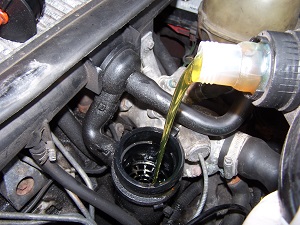Recent Posts
Categories
Benefits You Didn’t Know About Oil Changes
Automotive technology has come a long way since the mid-20th century, and so has motor oil. A 1940s-era car didn’t feature an oil pump or oil filter. Instead, they relied on dippers on the crankshaft’s counterweights, which would then sling oil to coat crucial moving parts. Motor oils in those days weren’t designed with detergents and other additives to help keep the engine clean; even with frequent oil change intervals, many cars would be in need of an engine overhaul by the time they reached 80,000 miles.
Today’s motor oil formulations incorporate additives to suspend contaminants in the oil so they can easily be trapped by the oil filter. Here are a few other facts about motor oil you may not have known:
· Motor oils contain antioxidants which limit exposure to oxygen for critical moving parts. Oxygen can lead to rust and corrosion.
· For years, the recommended oil change interval for conventional oil was every 3,000 miles. Today’s improved oils can now go for 5,000-7,500 miles between changes; in fact, automobile manufacturers now recommend those intervals.
· Synthetic motor oils can go much longer between changes and outperform conventional oils in every respect. Synthetics do not degrade and lose their lubricating properties as quickly and can flow better at lower temperatures. In fact, synthetics were originally developed by German scientists during WWII in response to shortages of petroleum and a need for lubricants which could remain fluid in sub-zero conditions on the Eastern Front.
· Like with other energy sources, bio-based motor oils are being developed. While still far from market phase, motor oils derived from canola, switchgrass, sawgrass and others are likely to be available in the next several years.
· Moisture tends to accumulate in an engine’s crankcase, and motor oil will boil off this condensation as it heats up and the engine reaches operating temperature. For cars driven less than ten miles per day, though, it’s recommended that the oil be changed more frequently to avoid the damage that comes from frequent cold startups.
· The first-ever emissions control device was the PCV valve; the valve redirects hydrocarbon gases from the crankcase back into the car’s intake manifold to be re-burned in the engine. The PCV valve became standard on early 60s-era cars and used to need replacement at regular intervals. Today’s motor oils are designed to not contaminate and clog the PCV valve.
· Motor oil shouldn’t be easy to ignite and burn; the distillation process used in refineries is called “fractional distillation,” and separates the desirable elements of motor oil from the more volatile components of crude oil, raising the temperature at which oil will burn.
We hope you found these facts about motor oil interesting! If you’re in need of an oil change (or can’t remember your last one), give us a call and let us take care of that for you. Remember, even with the improvements in motor oil technology of recent years, regular oil changes are still the simplest way of making sure you get the most miles out of your vehicle.

